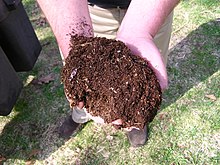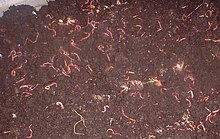Compost: Difference between revisions
ChemGardener (talk | contribs) m Reverted edits by 75.19.68.18 (talk) to last version by Wperdue |
|||
| Line 92: | Line 92: | ||
==External links== |
==External links== |
||
* [http://www.the-organic-compost.com The Guide to Compost] |
|||
* [http://www.goodgardeners.org.uk/index.html Good Gardener's Association - No Dig with compost] |
* [http://www.goodgardeners.org.uk/index.html Good Gardener's Association - No Dig with compost] |
||
* [http://www.compostmanual.com Compost Manual] |
* [http://www.compostmanual.com Compost Manual] |
||
Revision as of 23:08, 3 January 2010
It has been suggested that this article be merged with composting. (Discuss) Proposed since August 2009. |

Compost (Template:PronEng or US /ˈkɒmpoʊst/) is a combination of decomposed plant and animal materials and other organic materials that are being decomposed largely through aerobic decomposition into a rich black soil. The process of composting is simple and practiced by individuals in their homes, farmers on their land, and industrially by industries and cities.
Compost soil is very rich soil and used for many purposes. A few of the places that it is used are in gardens, landscaping, horticulture, and agriculture. The compost soil itself is beneficial for the land in many ways, including as a soil conditioner, a fertilizer to add vital humus or humic acids, and as a natural pesticide for soil. In ecosystems, compost soil is useful for erosion control, land and stream reclamation, wetland construction, and as landfill cover (see compost uses).
History
Composting as a recognized practice dates to at least the early Roman era since Pliny the Elder (AD 23-79) who refers to compost in his writings. Traditionally, composting was to pile organic materials and let them stand for about a year, or until the next planting season, at which time the materials would be ready for soil application. The main advantage of this method is that little working time or effort is required from the composter and it fits in naturally with agricultural practices in temperate climates. Disadvantages (from the modern perspective) are that space is used for a whole year, some nutrients might be leached due to exposure to rainfall, and disease producing organisms, some weeds, weed seeds and insects may not be adequately controlled.
Composting was somewhat modernized beginning in the 1920s in Europe as a tool for organic farming.[1] The first industrial station for the transformation of urban organic materials into compost was set up in Wels/Austria in the year 1921.[2] The early personages most cited for propounding composting within farming are for the German-speaking world Rudolf Steiner, founder of a farming method called biodynamics, and Annie Francé-Harrar, who was appointed on behalf of the government in Mexico and supported the country 1950-1958 to set up a large humus organization in the fight against erosion and soil degradation. In the English-speaking world it was Sir Albert Howard who worked extensively in India on sustainable practices and Lady Eve Balfour who was a huge proponent of composting. Composting was imported to America by various followers of these early European movements in the form of persons such as J.I. Rodale (founder of Rodale Organic Gardening), E.E. Pfeiffer (who developed scientific practices in biodynamic farming), Paul Keene (founder of Walnut Acres in Pennsylvania), and Scott and Helen Nearing (who inspired the back-to-land movement of the 1960s). Coincidentally, some of these personages met briefly in India - all were quite influential in the U.S. from the 1960s into the 1980s.
There are many modern proponents of rapid composting which attempt to correct some of the perceived problems associated with traditional, slow composting. Many advocate that compost can be made in 2 to 3 weeks [3]. Many such short processes involve a few changes to traditional methods, including smaller, more homogenized pieces in the compost, controlling carbon to nitrogen (CN) ratio at 30 to 1 or less, and monitoring the moisture level more carefully. However, none of these parameters differ significantly from early writings of Howard and Balfour, suggesting that in fact modern composting has not made significant advances over traditional organic practices. For this reason and others, many modern scientists who deal with carbon transformations are skeptical that there is a "super-charged" way to get nature to make compost rapidly. They also point to the fact that it is the structure of the natural molecules - such as carbohydrates, proteins, and cellulose - that really dictate the rate at which microbial-mediated transformations are possible.
Ingredients

Given enough time, all biodegradable material will oxidize to "compost". One objective of composting today is to treat readily degradable materials that may otherwise enter landfills, and decompose anaerobically, releasing greenhouse gases. Most small-scale domestic systems are not maintained at the thermophilic temperatures required to eliminate possible pathogens and disease vectors, or deter vermin, therefore pet droppings, meat scrap, and dairy products are best left to larger scale high-rate, aerobic composting systems. A local organics recycling facility may operate such a system. However, hobby animal manure (horses, goats, sheep, chickens), fruit and vegetable food materials and garden materials are excellent raw materials for home composting.
Major types of biodegradable organic materials used:
|

|
Inorganic additives
Uses
Compost is generally recommended as an additive to soil, or other matrices such as coir and peat, as a tilth improver, supplying humus and nutrients. It provides a rich growing medium, or a porous, absorbent material that holds moisture and soluble minerals, providing the support and nutrients in which plants can flourish, although it is rarely used alone, being primarily mixed with soil, sand, grit, bark chips, vermiculite, perlite, or clay granules to produce loam.
Generally, direct seeding into a compost is not recommended due to the speed with which it may dry and the possible presence of phytotoxins which may inhibit germination,[4][5][6] and the possible tie up of nitrogen by incompletely decomposed lignin.[7] It is very common to see blends of 20–30% compost used for transplanting seedlings at cotyledon stage or later.
As alternative to landfilling
As concern about landfill space increases, worldwide interest in recycling by means of composting is growing, since composting is a process for converting decomposable organic materials into useful stable products.[8] Industrial scale composting in the form of in-vessel composting, aerated static pile composting, and anaerobic digestion takes place in most Western countries now, and in many areas is mandated by law. There are process and product guidelines in Europe that date to the early 1980s (Germany, Holland, Switzerland) and only more recently in the UK and the US. In both these countries, private trade associations within the industry have established loose standards, some say as a stop-gap measure to discourage independent government agencies from establishing tougher consumer-friendly standards. See: UK[9] and for the US see [10]. The USA is the only Western country that does not distinguish sludge-source compost from green-composts, and by default in the USA 50% of states expect composts to comply in some manner with the federal EPA 503 rule promulgated in 1984 for sludge products.[11] Compost is regulated in Canada and Australia as well.
Standardization of the products
See also
- Anaerobic digestion
- Composting
- Composting toilet
- Compost tea
- Gardening
- Good Agricultural Practices
- Home composting
- Olive mill pomace compost
- John Innes Compost
- Leaf mold
- List of composting systems
- Mechanical biological treatment
- Micro-organisms
- Mulch
- Soil conditioner
- Vermicompost
- Waste management
- Bokashi composting
References
- ^ [http://www.trit.us/farming/history-organic-farming.html Heckman, J. 2006. A history of organic farming: transitions from Sir Albert Howard’s War in the Soil to USDA National Organic Program. Renew. Agric. Food Syst. 21:143–150.]
- ^ Welser Anzeiger vom 05. Januar 1921, 67. Jahrgang, Nr. 2, S. 4
- ^ [http://vric.ucdavis.edu/pdf/compost_rapidcompost.pdf (The Rapid Compost Method) by Robert D. Raabe, Professor of Plant Pathology, Berkeley
- ^ Morel, P. and Guillemain, G. 2004. Assessment of the possible phytotoxicity of a substrate using an easy and representative biotest. Acta Horticulture 644:417–423
- ^ Itävaara et al. Compost maturity - problems associated with testing. in Proceedings of Composting. Innsbruck Austria 18-21.10.2000
- ^ Phytotoxicity and maturation
- ^ Effect of lignin content on bio-availability
- ^ A Brief History of Solid Waste Management
- ^ British Standards Institute Specifications FAQ
- ^ [1]
- ^ U.S. Government Printing Office. 1998. Electronic Code of Federal Regulations. Title 40, part 503. Standards for the use or disposal of sewage sludge. Available at: http://ecfr.gpoaccess.gov/cgi/t/text/text-idx?c ecfr&tpl /ecfrbrowse/Title40/40cfr503 main 02.tpl. Accessed 30 March 2009.
Literature
- Insam, H; Riddech, N; Klammer, S (Eds.): Microbiology of Composting ,Springer Verlag, Berlin New York 2002, ISBN 978-3-540-67568-6
- Hogg, D., J. Barth, E. Favoino, M. Centemero, V. Caimi, F. Amlinger, W. Devliegher, W. Brinton., S. Antler. 2002. Comparison of compost standards within the EU, North America, and Australasia. Waste and Resources Action Programme Committee (UK) (see wrap.or.uk)
External links
- The Guide to Compost
- Good Gardener's Association - No Dig with compost
- Compost Manual
- Humanure
- Making Compost
- The Look of Compost
- Cré, the Irish Composting Association Information on composting in Ireland.
- Commission of the European Communities Landfill Directive Official Journal L 182 , 16/07/1999 P.0001-0019.
- UK Landfill Directive Information
- Compost Marketing in Switzerland, Schliess, K. 2002. Kompostvermarktung (in German) Report to the Swiss Agency for Environment, Bern.
- US EPA regulations for commercial compost use

